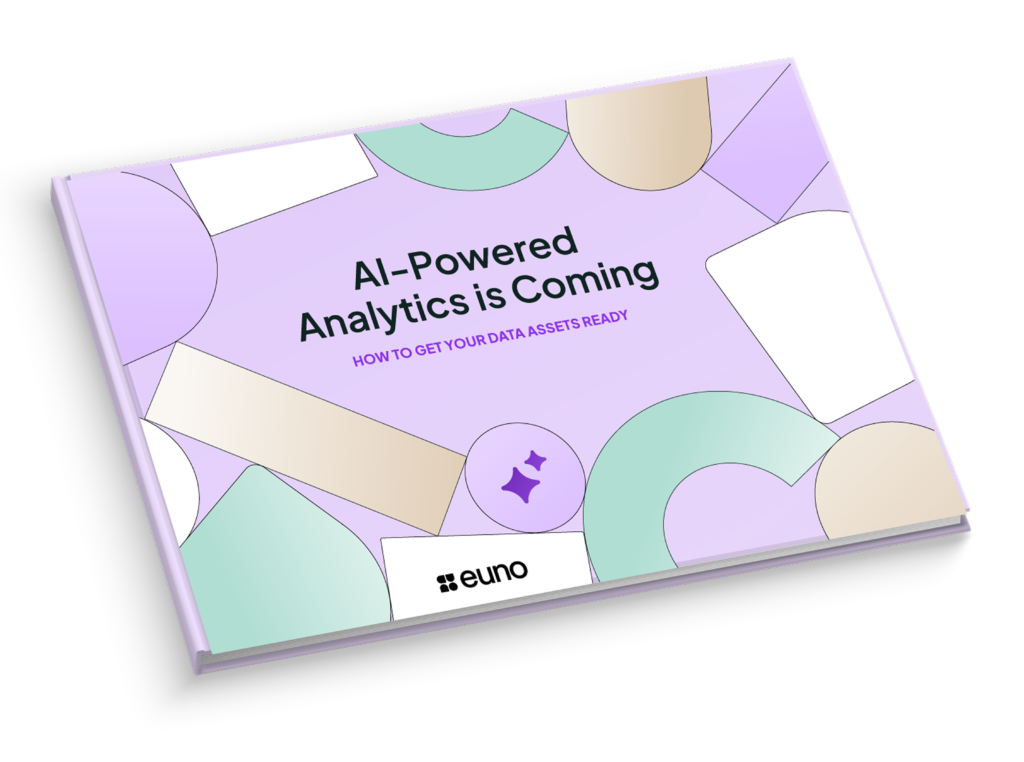You’ve got an AI-driven analytics initiative. You’re exploring agentic AI tools, and the potential is exciting. But before AI can deliver trusted, actionable insights, there’s a fundamental question you need to answer: Are your data assets ready?
The AI era is here
Generative AI is already changing the way people work, accelerating how teams actually deliver business impact. It’s no longer “nice-to-have”. It’s a must-have. As to data analytics, the expectation is simple: ask a question, get the right answer.
But making the right answers happen is far from simple.
AI tools don’t inherently understand business context. Without clear definitions, they make their best guess, and sometimes, they get it completely wrong.
Imagine this:
An AI agent is asked to identify the company’s most valuable customers—the premium users.
Yes, the “premium” tag exists in the CRM.
Yes, AI correctly pulls a list of accounts labeled “premium.”
Yes, the data pipeline works as expected.
And yet…
No, these aren’t actually the company’s top customers.
What happened? The “premium” tag was applied six months ago by a marketing campaign and the AI agent stumbled upon it. It didn’t “know” that real high-value customers are determined based on lifetime revenue, product engagement, and support tier and not using an outdated campaign label. Worse, the model that defines high-value customers lives in the BI layer together with other exploratory definitions.
LLMs are powerful, but without a trusted source of truth, they can’t tell what’s outdated and what’s accurate. Many think that cleaning the data and removing errors is enough to get AI-driven insights. But without consistent definitions, even perfectly clean data can still lead to conflicting answers.
The result? Misleading insights, lost trust, and poor decision-making.
A structured approach for trusted AI analytics
To prepare your organization for AI-driven analytics, you need governance. Governed metrics and definitions ensure that dashboards and reports using them are certified as trustworthy. The key is to create a system where definitions are standardized, data assets such as reports and dashboards are certified, and AI tools can be used with confidence.
The best way to achieve this is by building a certification program on top of a governed semantic model. This will create a good foundation for trust and consistency.
But what is a semantic model and a certification program?
A semantic model is a structured layer that defines and standardizes key business metrics. For GenAI, it powers text-to-SQL capabilities. Using the semantic model, AI can accurately answer natural language questions like, “What was our Customer Acquisition Cost (CAC) last quarter?” or, “How many active users did we have last month?”. The semantic model maps business intent to data using standardized definitions, and ensures every answer is accurate, reliable, and aligned with how your organization defines key metrics.
A certification program, on the other hand, ensures that data products, such as dashboards or reports, are reliable. When a dashboard is certified, it means that it meets governance standards and can be shared with confidence. This is what enables text-to-dashboards/reports. It’s important to highlight that not every dashboard or report can be trusted, even when the organization has a governed semantic model that ensures consistent definitions. Many dashboards and reports are created for exploratory analysis, quick ad-hoc reporting, or personal use. That means that they may not be accurate, up-to-date, or aligned with organizational standards.
A certification program allows AI to surface the most relevant, trusted dashboards, even when multiple versions exist. For example, if a user asks, “Show me our sales performance by region” AI needs to identify the certified version and present it to the user. The one that’s up to date, aligned with governed definitions, and free from ad-hoc custom logic. This ensures business users receive accurate, reliable insights without sorting through inconsistent reports.
Once your metrics and dashboards are governed, your AI agents need to interact with them effectively. AI should pull information only from reliable, certified sources, or at the very least, indicate when a data asset has a low governance score.
This way, you’ll build confidence in the data. When users learn to trust genAI responses, they’ll stop questioning every number. That’s how you drive real adoption and improve the overall experience of engaging with the data.
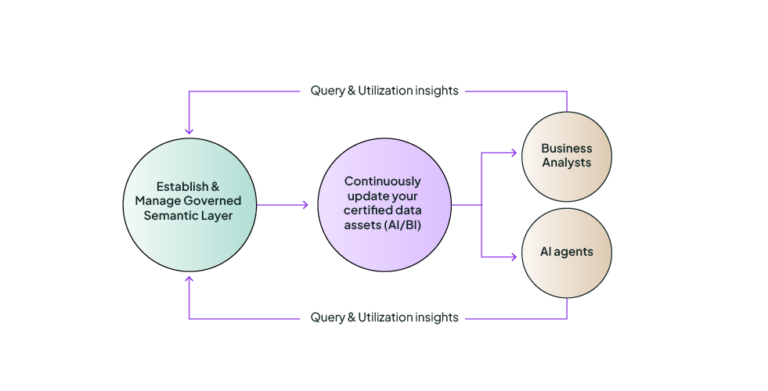
Establish and maintain your semantic model
There’s no shortcut here: having a governed semantic model is critical if you want to implement AI-driven data analytics. It’s the foundation that allows AI tools to interpret business questions accurately and deliver consistent, reliable insights. If text-to-SQL is part of your AI vision, you need a governed semantic model – full stop.
So, how do you get started?
1. Choose where to build your semantic model
There are many ways to establish a semantic model, but we believe the most effective approach is to implement it at the data layer, using tools like dbt semantics. Why? Building at the data layer ensures that your semantic model is shared across all data users and applications. This allows for consistency and alignment across every platform that interacts with your data—whether it’s a BI analyst or an AI agent.
2. Move key metrics into the semantic model
Not every metric needs to be part of your semantic model. Focus on metrics that deliver the most value by ensuring consistency and reducing redundancy. Here’s how to identify which metrics to prioritize:
- Highly utilized: Metrics frequently queried and referenced are likely the most impactful. Governing these first ensures consistency where it matters most.
- Used across multiple teams: If a metric is referenced in different reports and dashboards, centralizing it ensures consistency and eliminates discrepancies. Update it once, and it updates everywhere.
- Critical for long-term decisions: Prioritize metrics that inform ongoing business performance rather than temporary, project-specific ones.
- Complex calculations: Metrics with intricate logic are best defined centrally to ensure accuracy and minimize downstream errors.
Once a key metric is identified, there should be a structured way to integrate it into the semantic model. This could be as simple as opening a ticket when a metric gains traction or defining a workflow for teams to submit new metrics for review.
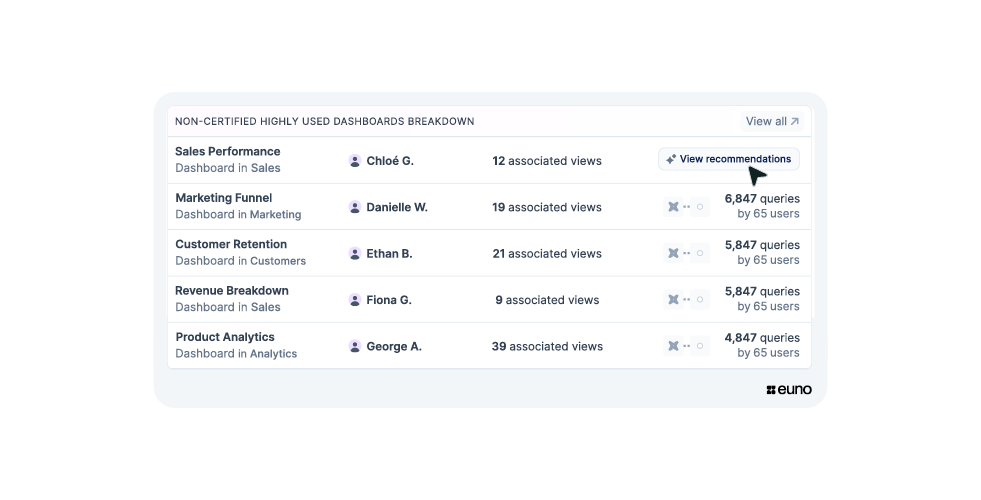
3. Declutter and resolve conflicts
Identify metrics that are duplicated, unused, or conflicting. Removing what’s not needed and resolving discrepancies keeps your semantic environment clean and focused, making it easier for AI to deliver precise answers.
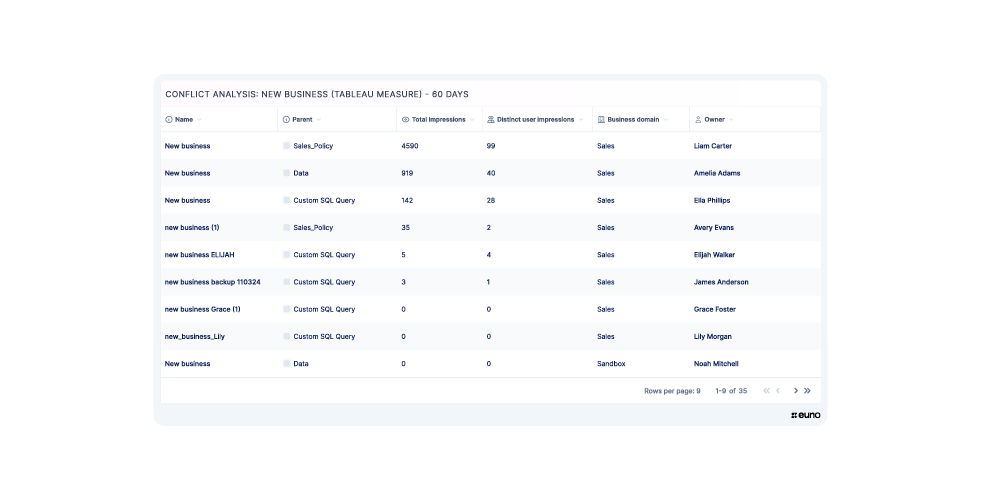
4. Monitor your data ecosystem for new definitions
A semantic model isn’t static—it evolves with your organization. When a new metric gains traction, evaluate whether it should be added to the semantic model or replace an existing metric. Similarly, deprecate metrics that are no longer relevant.
Certify your dashboards
Even with a governed semantic model, AI agents still need to know which dashboards and reports can be trusted. A certification program helps distinguish between reports built on validated, governed data and those created for exploratory or one-off analysis.You can help AI agents navigate dashboards sprawl by implementing a certification program. Here’s how to get this done.
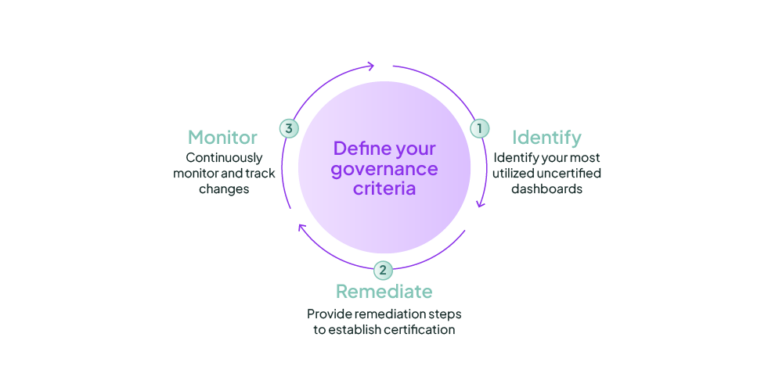
1. Define your governance criteria
Before AI can confidently surface reports, you need clear standards for what makes a dashboard reliable. However, you don’t have to enforce strict rules from day one. Start with a simple, flexible framework and refine it over time. An initial certification framework might include:
- No raw SQL logic embedded in BI tools (avoiding direct, unmanaged SQL queries)
- Built on production-grade tables (such as dbt marts) or other managed layer in the BI tool
- Clearly assigned ownership (so accountability is established for maintenance and updates)
- As governance matures, you can begin to introduce stricter criteria, such as:
- Restricting transformations to governed modeling layers
- Enforcing documentation and auditability standards
- Ensuring reports use only definitions from the semantic layer
2. Start with the dashboards that matter most
Once your governance criteria are set, you need to verify that dashboards and reports comply. You can do this manually or use tools like Euno to automate the process.
One of the biggest challenges in certification is knowing where to start. Organizations often have thousands of dashboards and reports, creating sprawl. Many of them are rarely used.
Identifying the most utilized dashboards will let you focus on what matters most.
If a highly used dashboard is not certified, provide full visibility into why it doesn’t meet governance standards.
Notify the owner and offer clear remediation steps. Once you bring this dashboard into compliance, it can be used by AI agents with confidence.
3. Continuously monitor and maintain certification
Certification isn’t a one-time process. Data environments are constantly evolving. A dashboard that met governance standards today might become outdated tomorrow due to schema changes, evolving business definitions, or new data sources. Track dashboards continuously and flag those that fall out of compliance to keep AI agents working with reliable data
Connecting AI Agents
Your AI-driven data analytics initiative depends on trust and for AI to deliver trustworthy results, it needs to be able to query the governance status of data products and make decisions accordingly. The best way to enable this is by connecting your AI agents to your governance data via an API.
To answer ad-hoc questions and build predictive models:
For queries like, “What was our MRR last year?” or predictive scenarios like, “If we reduce churn by 5%, how will this impact revenue?” AI agents need direct access to governance data, ideally via API, or a natural language interface, so they can pull only governed metrics and definitions. It will ensure every answer is accurate, consistent, and aligned with how the organization defines its key metrics.
To surface existing dashboards and reports:
When users ask, “Does this dashboard exist?” or, “Show me our sales performance by region,” AI agents shouldn’t just pull the first report they find. They need to check whether it’s certified and aligned with governance standards. By querying the source of truth, they can confidently surface the most trusted report and avoid irrelevant or outdated versions.
AI-ready data is simple to do
Getting your data AI-ready doesn’t have to be overwhelming. Start with quick wins: . Invest in your semantic model so AI can reliably interpret business questions and pull the right metrics. Certify your most-used dashboards. Finally, make sure AI agents have access to governance information (whether through an API or a natural language model) so they can confidently surface trusted insights.
From us to you: more practical tips
Execution matters just as much as strategy. Here are some operational considerations to ensure your AI-powered analytics initiative gains traction and delivers real value.
Start where it counts
Don’t try to govern everything at once. Instead, start with a limited set of tables. Choose high-impact areas where trusted data will make the biggest difference such as company-wide KPIs. Then, prioritize domains like revenue reporting, customer analytics, or operational metrics: areas where improved accuracy will immediately benefit decision-making. Once you’ve built a good foundation and solid processes, expand to your entire data ecosystem.
Engage your early adopters
The right first users can make all the difference. Identify data-driven teams who are willing to provide feedback, refine governance processes, and test AI-powered insights. Their input will help iron out issues and validate that certified reports and semantic definitions truly support business needs.
Monitor, iterate, and scale
Governance isn’t a one-time setup, it evolves. Continuously track data usage, identify gaps, and refine your certification and semantic model processes. As adoption grows, expand governance to additional domains, ensuring AI continues to operate on high-quality, trusted data.
Follow this and your AI analytics initiative won’t just be another experiment, it will deliver real, reliable impact
Get your data assets AI-ready, and start now
AI has already changed the way we work, and analytics is next. But unlocking its full potential requires more than just technology, it requires consistency on how you define your metrics.
You don’t have to tackle everything overnight. Take small, strategic steps. Just don’t wait for everything to be perfect. Start by focusing on what matters most: certifying the reports business users rely on, governing key definitions, and eliminating the noise that slows teams down.
Euno makes this process easier by highlighting the most impactful areas first, flagging inconsistencies, surfacing high-priority issues, and ensuring AI agents operate with trusted, governed data products.
Explore how Euno can help you with your AI-powered analytics initiative.
